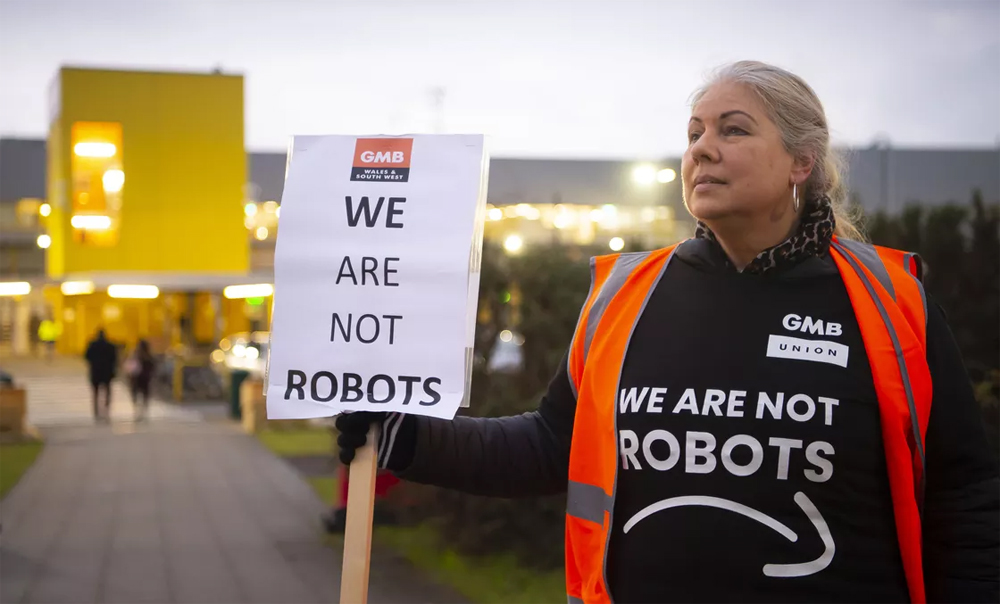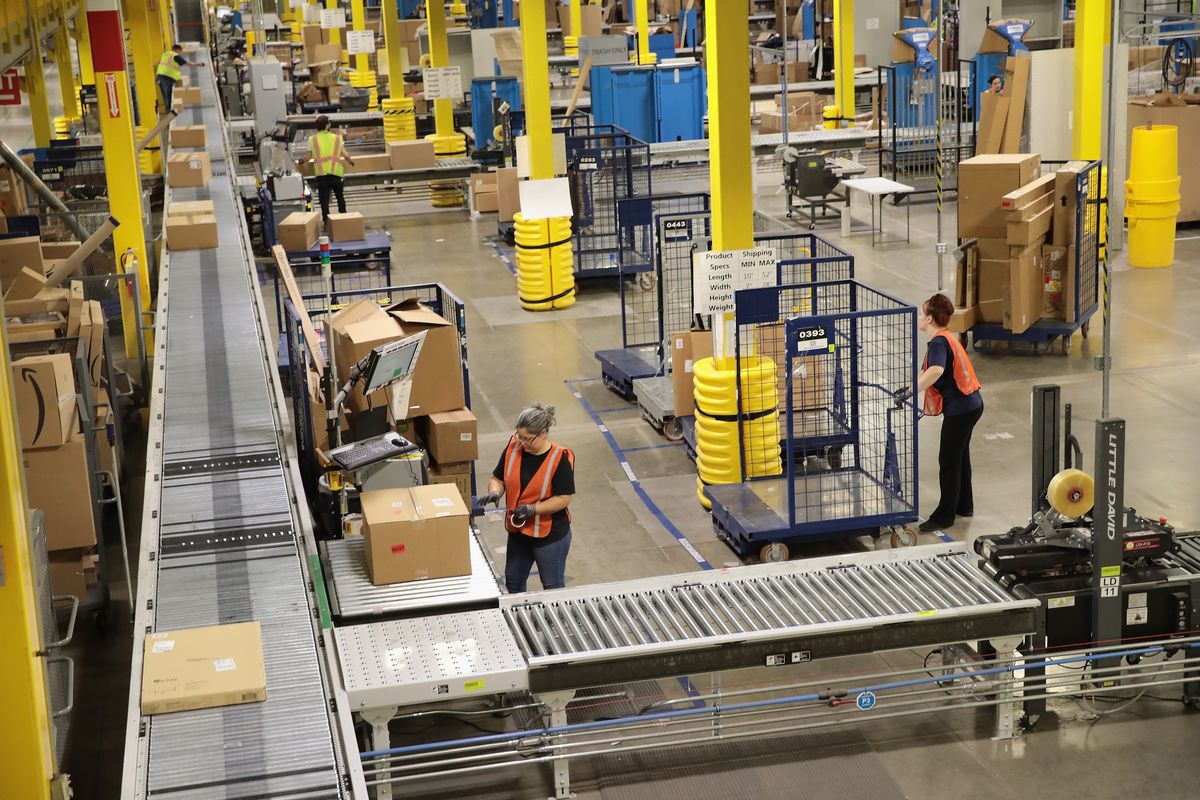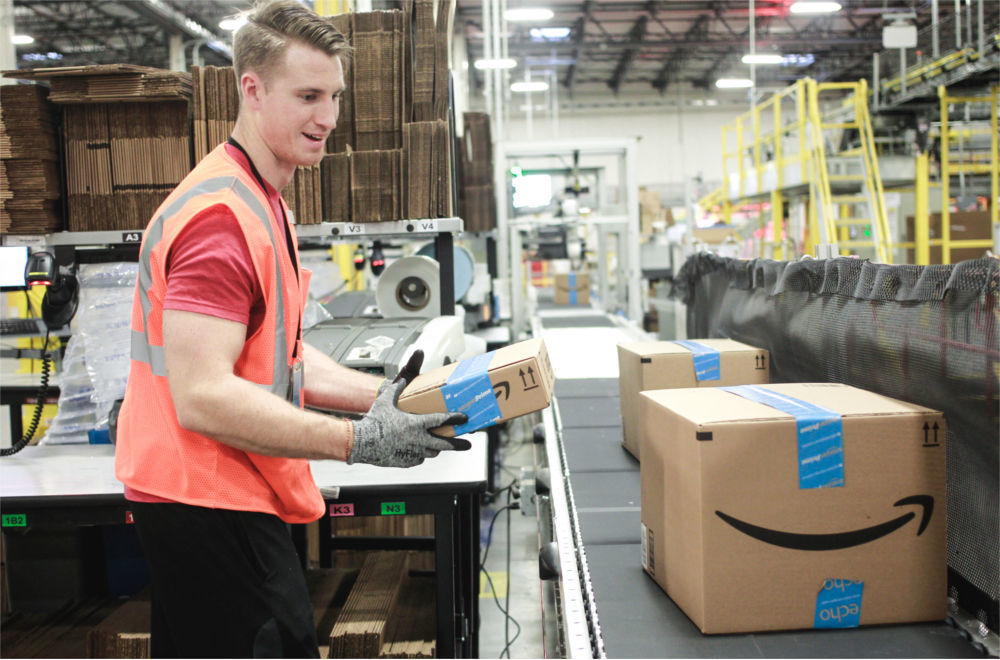How Amazon Algorithms Determine Who It Is Time to Dismiss

Amazon in the USA has 110 large warehouses, 75 execution centers, 45 sorting centers and 50 delivery stations. Robots so far cannot cope with all this good: the company says that it will take at least 10 more years for full automation. Therefore, all these facilities employ more than 125,000 full-time employees of the company. All of them need to be controlled so that not a single product lingers on the way to the buyer. How to do it? While the algorithms can not cope with the physical work, they appear to be busy with the most important: they fire people.
Amazon Executive Centers are the company's main driving force. Huge warehouses with an area of 100,000 m2, where employees receive, distribute, sort, track, package and send tens of thousands of parcels every day. Critics say that in these centers, many people experience almost inhuman working conditions every day, afraid of losing their jobs. A journalist from Britain worked at Amazon's warehouse for a month, and reported that many of his colleagues were forced to write in bottles to meet the norm. If you do not manage to pack 240 (sometimes up to 400) boxes per hour or do not select the goods fast enough, you immediately become a candidate for dismissal.

“Their logistics system is built to ensure that people develop themselves to the bone and then be replaced by others,” says one of Amazon's warehouse managers, a former US Air Force veteran. “And there is always someone behind you who is ready to get your position.”
Amazon has always found answers to critics. Including stating that her conditions and salary are better than that of other retailers, and information about the constant fear of dismissals is greatly exaggerated. But the other day in the hands of Vox was a document calling such statements into question. In fact, dismissals due to "underfulfillment of norms" occur even more often than insiders thought. Just few people linger so long to collect statistics.
The full document (35 pages, mostly tables with productivity values for each of the employees that are shaded for privacy reasons) is available here . This is a letter from a lawyer from Morgan Lewis representing Amazon in one of the cases opened against the company due to an “unfair dismissal”. In it, the lawyer, Carey Crystal, reports that the rules for employees are issued by an algorithm from the outside and apply to the whole center, that is, to each employee in it, and cannot be modified internally, even if you did not like it (or, on the contrary, liked it very much) to the manager. And the system issuing warnings and ordering dismissal is “extremely objective”.

Muslims working in the Amazon warehouse in Minneapolis protest because they don’t have time to pray (they are given 2 breaks of 15 minutes on Ramadan)
The document reveals some of the secrets of the company. For example, it turns out that from a warehouse in Baltimore (where Barbara Duvall worked, who complained about Amazon), about 300 full-time employees (i.e., internships and permanent employees, and not on Prime Day or Christmas) were fired in a year . This is out of 2500 people working there. If this pace of layoffs is constant, it means that Amazon annually dismisses more than 10% of its employees. The company has more than 125,000 employees in America, which means that thousands of people lose their jobs every month due to the insufficient movement of goods and boxes.
And these are just layoffs for reasons of non-compliance with the productivity standards that the algorithms track. In fact, Amazon has a lot more stuff. Employees can also be fired by managers (for example, for antisocial behavior) or they can quit themselves, unable to withstand the pace of work.
Critics of the system (mostly Amazon workers themselves) say that this machine only sees numbers, not the people behind them. Stacy Mitchell, director of the Institute for Self-Sufficiency, says that employees of executive centers regularly come to her center for financial or social support. “I constantly hear from them that they feel completely interchangeable, like cogs in a system. They are treated like robots because they are constantly monitored and evaluated by these automatic systems. Robots want the same robots to work for them. ”

The main indicator of your effectiveness in the system, according to the Amazon lawyer’s document, is “time off task” (ToT). The lower it is, that is, the less you relax, the better. Other performance indicators are secondary. Even if you are the soul of the company and have not taken a weekend for ten years, it is enough to miss two hours and you are fired. In 30 minutes you receive a written warning, 1 hour - the last warning. Hence the workers who are afraid to take a break to the toilet. If you take too long, it can be a warning, and if you get several of these in one month - goodbye, work.

Amazon says that the pace of work is set for all warehouse employees, and only slows down if more than 75% of them fail to meet their standards. The worst 5% are sent to the training program, and if their results there do not improve, then the dismissal also follows. If the employee does not agree with the decision, you can try to challenge it within the company.
Actually, that was how they fired Barbara Duvall, who went to court: for several weeks she performed tasks at a rate of 72-93% of the norm. It was especially tight with the packaging and scanning speed of barcodes of goods. The algorithm sent her to training, where she was shown a faster way to scan. She did not follow him, the pace improved, but not by much. In parallel, Barbara tried to fight for the “rights of the workers” (Amazon says that only for their rights do not work). Soon she was fired, along with several hundred other “lazy people”. Barbara is sure that she was fired for her protest activity, but Amazon has all the numbers, her indicators for each week.
The company representative in a letter responded in defense of Amazon:
Only about three hundred people in Baltimore were fired during this time due to insufficient productivity. In general, the number of laid-off employees in the last two years has decreased both at this facility and in North America as a whole. Our systems automatically set standards based on parameters such as warehouse location and demand in this region. We do not demand the impossible from people.
Perhaps the most amazing thing about all this is that people are still surprised when the software begins to deal with issues of layoffs. AI has been selecting job seekers for several years , working as a project manager , and Walmart - and managing the store . Time attendance systems have long been used to evaluate the activity of office employees. On-board computers on trucks in the United States check the speed, gear changes and engine revolutions per minute to monitor the quality of the trucker's work. Cash terminals in large stores monitor the pace of the cashier, and if he scans goods too slowly, they give him a signal.
All of these systems are already helping employers decide who needs to be fired. Amazon simply moved on to the next logical stage, and ceased to demand permission from people managers, finally putting the figures at the forefront. Soulless But effective!

Own employees for the company are the most consumable goods, as much as the laws allow. Customers are a priority for all issues. Only a few days ago, Bezos announced that he would spend $ 800 million so that customers of the company in the USA, signed on Prime, received goods within the same day. This will be achieved, among other things, by opening new executive centers. This is despite the fact that Amazon products arrive at our warehouse in the United States on average in two to three days, this is the fastest delivery from stores. But Bezos believes that the speed of their work is the main competitive advantage of the company. And a minute delay (for example, because of an employee who decided to take a break) can prevent him from realizing this advantage.
Such a strategy brings good results to the company. April 25, Amazon released a quarterly report according to which in January-March, the Internet giant has more than doubled its net profit. It reached a historic high and amounted to $ 3.561 billion (compared with $ 1.629 billion a year earlier). Revenue rose 17% to $ 59.7 billion. On such news, Jeff Bezos’s fortune exceeded $ 160 billion. This is more than 40 million of the poorest Americans.

